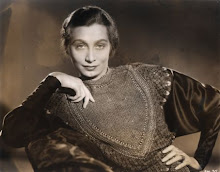
It opened in 1928, I am told, but did not become part of my world, and later my history, until around 1940. It was on Tremont Avenue, a major east-west Bronx thoroughfare, just one half block from the Grand Concourse. The Devon Theatre was my first film school. We called it the
Dee-von, not Devon (as in Evan). And it was neither picturesque nor palatial. It was a small 600 seat Art Deco movie house in the mid-Bronx, two blocks from where I lived. Perhaps I saw my first movie there, perhaps not. Try to remember.
But the Devon soon became my first film school. The curriculum did not start with Griffith, Eisenstein, or the Danes. It was a third run house -- the movies that came there reached its confines last -- usually tired prints accompanied by worn and folded one sheets, half sheets, and lobby cards.
Prints of these films had by then descended from the likes of Radio City, the Roxy, the Capitol, and lesser venues. When projected, they glistened less, perhaps, because of their meandering journeys. But, I suspect, as poor print quality took its toll on the images of those oversized studio performers -- I noticed little, or not at all.
The range of films was eclectic. And there was certainly a copious sampling of such as
When the Daltons Rode, a rhythmic title that stays in mind, or similar western fare. It was a bit early for the deluge of war films but they were soon to come. And Maisie and Boston Blackie were in evidence. So the distribution cycle went from opulent to Poverty Row.
These were the first movies of what would become, as best as I can calculate, well more than ten thousand seen in a lifetime. In the Devon, I saw the forties films in the forties and the early fifties films in the early fifties. And some thirties films found their way into that broad two decade montage.
The faculty at my first film school, as best I recall, was six in number. Try to remember. There was a girl or a lady in a glass and metal box out front who dispensed tickets. A little man in a red jacket at the inner entrance took my ticket, tore it in half, returned a piece and placed the other half into a waist-high wooden box, behind which he stooped. At quiet moments, he sat on a small stool. There was a matron, with a flashlight, dressed as nurses used to dress, a projectionist (unseen) and a lady behind a candy counter. (Popcorn was a futuristic concept then and even in later years that would be upscale Bronx anyway.) I suppose there was a manager somewhere.
Course materials were a blank slate of mind, and remembrance of tales previously told by others of things seen in the dark – larger than life images cast upon a screen. The only qualification was young eyes waiting to see such illusion. There was no cafeteria or commissary. We ate on the premises: candy in little boxes most often, something with a lot of little pieces. Unmentionable things moved on the floor there, as they did at home, but I did not see them. My eyes were affixed on the screen as I sat behind the fourth wall.
By some strange confluence of events and coincidence, the photograph shows the Devon just about the time I was coming of age (for movies). It is almost certainly from 1940, when at six years of age I was likely first taken there. It was when I was about to be enrolled in my first film school. The photograph shows the structure as I recall it – abutted by a group of stores that I still remember well. I have in later years seen the films displayed on the marquee.
Like any good school, there was connectivity with other institutions of advanced learning and these had names like the Avalon, the Jerome, the Fox Crotona, the Loew’s Burnside and the Loew’s Paradise. And foreign languages were heard in the distance and later beckoned me to the Ascot and the Lido. But those were film schools for other days or later times -- tales of which might be told in some future posting. Try to remember.
 An epilogue
An epilogue
The lower photograph was taken some twenty years and two wars later: Easter Sunday, 1960. The film school can be seen, apparently still operating. At that time, when the flight to the suburbs was already in full force, some students remained just a little while longer. Much of the Bronx eventually went into uncertainty, decay and ruin. The Devon, far less fortunate, became the location of two ordinary stores. Current Internet mapping sites indicate the stores are still there on a business street in a tired borough. I keep hoping they are false fronts.Note: The photograph of the Devon Theatre is courtesy of Cinema Treasures.


 The Onslow Ford statue when it was at Khartoum.
The Onslow Ford statue when it was at Khartoum.
 Cover illustration from the book: East of Eden.
Cover illustration from the book: East of Eden.






